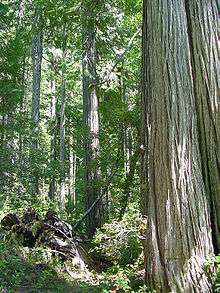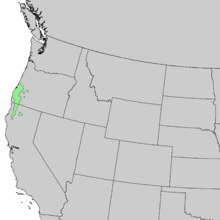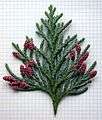Chamaecyparis lawsoniana
| Chamaecyparis lawsoniana | |
|---|---|
 | |
| Old-growth stand of C. lawsoniana in California | |
| Scientific classification | |
| Kingdom: | Plantae |
| Division: | Pinophyta |
| Class: | Pinopsida |
| Order: | Pinales |
| Family: | Cupressaceae |
| Genus: | Chamaecyparis |
| Species: | C. lawsoniana |
| Binomial name | |
| Chamaecyparis lawsoniana | |
 | |
| Natural range of Port Orford cedar | |
Chamaecyparis lawsoniana, known as Port Orford cedar[2] or Lawson cypress,[3] is a species of conifer in the genus Chamaecyparis, family Cupressaceae. It is native to Oregon and northwestern California, and grows from sea level up to 1,500 m (4,900 ft) in the valleys of the Klamath Mountains, often along streams.
Description
It is a large evergreen tree, maturing up to 197 ft (60 m) tall or more, with trunks 4–7 ft (1.2–2 m) in diameter, with feathery foliage in flat sprays, usually somewhat glaucous (i.e. blue-green) in color. The leaves are scale-like, 1⁄8–3⁄16 inch (3–5 mm) long, with narrow white markings on the underside, and produced on somewhat flattened shoots. The foliage gives off a rather pungent scent, not unlike parsley. The seed cones are globose, 9⁄32–9⁄16 inch (7–14 mm) diameter, with 6-10 scales, green at first, maturing brown in early fall, 6–8 months after pollination. The male cones are 1⁄8–5⁄32 inch (3–4 mm) long, dark red, turning brown after pollen release in early spring. The bark is reddish-brown, and fibrous to scaly in vertical strips.
History and names
It was first discovered (by Euro-Americans) near Port Orford in Oregon and introduced into cultivation in 1854, by collectors working for Charles Lawson FRSE[4] of the Lawson & Son nursery in Edinburgh, Scotland, after whom it was named as Lawson Cypress by the describing botanist Andrew Murray. The USDA officially calls it by the name Port Orford cedar,[5] as do most people in its native area, but some botanists prefer to use the name Lawson cypress (or in very rare instances Port Orford cypress) instead. The name "Lawson's cypress" is widely used in horticulture.
Prehistory
The extinct Eocene species Chamaecyparis eureka, known from fossils found on Axel Heiberg Island in Canada, is noted to be very similar to Chamaecyparis pisifera and C. lawsoniana.[6]
Wood
The wood is light yet has great strength and rot resistance, and is particularly highly valued in east Asia, with large amounts being exported to Japan where it is in high demand for making coffins, and for shrines and temples.[7] Its lumber is also known for its highly fragrant ginger aroma. Due to the straightness of its grain, it is also one of the preferred woods for the manufacture of arrow shafts. It is also considered an acceptable, though not ideal, wood for construction of aircraft.[8]
However, it is considered more than acceptable for use in stringed instruments. Its fine grain, good strength and tonal quality are highly regarded for soundboards in guitar making.[9]
Cultivation
Chamaecyparis lawsoniana thrives best in well-drained but moist soils, in a fairly sheltered position in full sun.Several hundred named cultivars of varying crown shape, growth rates and foliage colour have been selected for planting in parks and gardens. In the UK the following have gained the Royal Horticultural Society's Award of Garden Merit (confirmed 2017):-[10]
| Name | Height (m) | Spread (m) | Shape | Foliage Colour | Ref. |
|---|---|---|---|---|---|
| 'Aurea Densa' | 1.5 | 1.0 | broadly conical | yellow-green | [11] |
| 'Chilworth Silver' | 2.5 | 1.0 | broadly columnar | silver-blue | [12] |
| 'Dik's Weeping' | 12.0 | 4.0 | columnar, weeping | blue-green | [13] |
| 'Ellwoodii' | 8.0 | 4.0 | columnar | grey-green | [14] |
| 'Ellwood's Gold' | 4.0 | 1.0 | columnar | yellow/grey-green | [15] |
| 'Ellwood's Pillar' | 2.5 | 1.5 | narrowly columnar | grey-green | [16] |
| 'Fletcheri' | 12.0 | 4.0 | columnar | grey-green | [17] |
| 'Gimbornii' | 2.5 | 2.5 | rounded | grey-green | [18] |
| 'Golden Wonder' | 20.0 | 4.0 | columnar | yellow-green | [19] |
| 'Grayswood Feather' | 4.0 | 1.5 | narrowly columnar | green | [20] |
| 'Green Globe' | 0.3 | 0.3 | rounded | dark green | [21] |
| 'Imbricata Pendula' | 8.0 | 4.0 | conical, weeping, pendulous | green | [22] |
| 'Kilmacurragh' | 12.0 | 4.0 | columnar | dark green | [23] |
| 'Lanei Aurea' | 8.0 | 2.5 | columnar | yellow-green | [24] |
| 'Little Spire' | 2.5 | 1.5 | conical | dark green | [25] |
| 'Minima Aurea' | 1.0 | 1.0 | conical | yellow-green | [26] |
| 'Minima Glauca' | 2.5 | 2.5 | rounded | blue-green | [27] |
| 'Pembury Blue' | 12.00+ | 8.00 | conical | blue-green | [28] |
| 'Pygmaea Argentea' | 2.5 | 1.0 | rounded | cream/blue-green | [29] |
| 'Stardust' | 4.0 | 1.5 | columnar | yellow-green | [30] |
| 'Summer Snow' | 2.5 | 1.5 | conical | cream/green | [31] |
| 'Triomf van Boskoop' | 25.0 | 8.0 | broadly columnar | grey-green | [32] |
| 'Wisselii' | 12.0+ | 4.0 | narrowly conical | blue-green | [33] |
| 'Wissel's Saguaro' | 6.0 | 1.0 | narrow, upright | blue-green | [34] |
Disease
In the wild, the species is seriously threatened by a root disease caused by the introduced oomycete pathogen, Phytophthora lateralis. This disease is also a problem for horticultural plantings in some parts of North America. The tree is sometimes killed, though less often, by other species of Phytophthora.
Phytophthora lateralis infection begins when mycelium, from a germinated spore, invade the roots. The infection then spreads through the inner bark and cambium around the base of the tree. Spread up the trunk is generally limited. Infected tissue dies and effectively girdles the tree. Large trees are more likely to be infected than small trees due to larger root areas (although all trees at the edges of infected streams will eventually succumb). However, large trees can often live with the infections for a longer duration (up to several years).
C. lawsoniana in streamside populations are highly susceptible to Phytophthora lateralis infection. However, the rate of Phytophthora spread through populations in dry upland areas appears to be slow. Phytophthora lateralis spreads through water via mobile spores (zoospores). The fungus also produces resting spores (chlamydospores) that can persist in soil for a long period of time. New infections generally begin when soil is transferred from an infected population to a non-infected population via human or animal movement. After initial infection in streamside populations, secondary spread via zoospores quickly infects all downstream individuals.
Human facilitated spread is thought to be responsible for most new, and all long-distance, infections. Soil on vehicle tires, especially logging trucks and other off road vehicles, is considered the most pressing problem due to the volume of soil that can be carried and the traffic rate in and between susceptible areas. Spread on boots and mountain bike tires has also been suggested and probably contributes to new infections locally.[35] Animal facilitated spread is thought to occur, but is localized.
The Bureau of Land Management (BLM) and United States Forest Service (USFS) attempt to prevent Phytophthora spread through road closures, monitoring, research and education. Research has focused on determining the dynamics and mechanisms of spread, as well as attempts to breed resistant trees. One solution against Phytophtera is known generically as Mancozeb and also commercially known as Dithane (C). Commercial preparations of the parasitic fungus Pythium oligandrum are licensed for pest control, and documented to predate many species of Phytophthora.[36]
See also
Gallery
 foliage with cones: immature seed cones below, pollen cones above
foliage with cones: immature seed cones below, pollen cones above male cones in spring with diagnostic red colour
male cones in spring with diagnostic red colour mature female cones
mature female cones Cultivar ‘Imbricata Pendula’, Rosemoor, Devon, UK
Cultivar ‘Imbricata Pendula’, Rosemoor, Devon, UK
References
- Snyder, Gary. 1999. "The Gary Snyder Reader". Counterpoint. ISBN 1-887178-90-2
- ↑ Farjon, A. 2013. Chamaecyparis lawsoniana. In: IUCN 2013. IUCN Red List of Threatened Species. Version 2013.1. <www.iucnredlist.org>. Downloaded on 13 July 2013.
- ↑ "Chamaecyparis lawsoniana". Natural Resources Conservation Service PLANTS Database. USDA. Retrieved 22 March 2015.
- ↑ "BSBI List 2007". Botanical Society of Britain and Ireland. Archived from the original (xls) on 2015-01-25. Retrieved 2014-10-17.
- ↑ Biographical Index of Former Fellows of the Royal Society of Edinburgh 1783–2002 (PDF). The Royal Society of Edinburgh. July 2006. ISBN 0 902 198 84 X.
- ↑ "Chamaecyparis lawsoniana". Natural Resources Conservation Service PLANTS Database. USDA.
- ↑ Kotyk, M.E.A.; Basinger, J.F.; McIlver, E.E. (2003). "Early Tertiary Chamaecyparis Spach from Axel Heiberg Island, Canadian High Arctic". Canadian Journal of Botany. 81 (2): 113–130. doi:10.1139/B03-007.
- ↑ Snyder 1999 pg. 225
- ↑ Kroes, Watkins, and Delp: Aircraft Maintenance and Repair, sixth edition, page 66, McGraw Hill, 1993
- ↑ "Port Orford Cedar tops". Luthiers Mercantile International, Inc.
- ↑ "AGM Plants - Ornamental" (PDF). Royal Horticultural Society. July 2017. p. 16. Retrieved 24 January 2018.
- ↑ "Chamaecyparis lawsoniana 'Aurea Densa'". RHS Gardening. Royal Horticultural Society. Retrieved 30 January 2018.
- ↑ "Chamaecyparis lawsoniana 'Chilworth Silver'". RHS Gardening. Royal Horticultural Society. Retrieved 30 January 2018.
- ↑ "Chamaecyparis lawsoniana 'Dik's Weeping'". RHS Gardening. Royal Horticultural Society. Retrieved 2013-01-28.
- ↑ "Chamaecyparis lawsoniana 'Ellwoodii'". RHS Gardening. Royal Horticultural Society. Retrieved 30 January 2018.
- ↑ "Chamaecyparis lawsoniana 'Ellwood's Gold'". RHS Gardening. Royal Horticultural Society. Retrieved 30 January 2018.
- ↑ "Chamaecyparis lawsoniana 'Ellwood's Pillar'". RHS Gardening. Royal Horticultural Society. Retrieved 26 January 2018.
- ↑ "Chamaecyparis lawsoniana 'Fletcheri'". RHS Gardening. Royal Horticultural Society. Retrieved 30 January 2018.
- ↑ "Chamaecyparis lawsoniana 'Gimbornii'". RHS Gardening. Royal Horticultural Society. Retrieved 30 January 2018.
- ↑ "Chamaecyparis lawsoniana 'Golden Wonder'". RHS Gardening. Royal Horticultural Society. Retrieved 30 January 2018.
- ↑ "Chamaecyparis lawsoniana 'Grayswood Feather'". RHS Gardening. Royal Horticultural Society. Retrieved 30 January 2018.
- ↑ "Chamaecyparis lawsoniana 'Green Globe'". RHS Gardening. Royal Horticultural Society. Retrieved 30 January 2018.
- ↑ "Chamaecyparis lawsoniana 'Imbricata Pendula'". RHS Gardening. Royal Horticultural Society. Retrieved 30 January 2018.
- ↑ "Chamaecyparis lawsoniana 'Kilmacurragh'". RHS Gardening. Royal Horticultural Society. Retrieved 21 January 2018.
- ↑ "Chamaecyparis lawsoniana 'Lanei Aurea'". RHS Gardening. Royal Horticultural Society. Retrieved 30 January 2018.
- ↑ "Chamaecyparis lawsoniana 'Little Spire'". RHS Gardening. Royal Horticultural Society. Retrieved 21 January 2018.
- ↑ "Chamaecyparis lawsoniana 'Minima Aurea'". RHS Gardening. Royal Horticultural Society. Retrieved 30 January 2018.
- ↑ "Chamaecyparis lawsoniana 'Minima Glauca'". RHS Gardening. Royal Horticultural Society. Retrieved 21 January 2018.
- ↑ "Chamaecyparis lawsoniana 'Pembury Blue'". RHS Gardening. Royal Horticultural Society. Retrieved 30 January 2018.
- ↑ "Chamaecyparis lawsoniana 'Pygmaea Argentea'". RHS Gardening. Royal Horticultural Society. Retrieved 30 January 2018.
- ↑ "Chamaecyparis lawsoniana 'Stardust'". RHS Gardening. Royal Horticultural Society. Retrieved 21 January 2018.
- ↑ "Chamaecyparis lawsoniana 'Summer Snow'". RHS Gardening. Royal Horticultural Society. Retrieved 30 January 2018.
- ↑ "Chamaecyparis lawsoniana 'Triomf van Boskoop'". RHS Gardening. Royal Horticultural Society. Retrieved 30 January 2018.
- ↑ "Chamaecyparis lawsoniana 'Wisselii'". RHS Gardening. Royal Horticultural Society. Retrieved 30 January 2018.
- ↑ "Chamaecyparis lawsoniana 'Wissel's Saguaro'". RHS Gardening. Royal Horticultural Society. Retrieved 21 January 2018.
- ↑ Soden, Tabitha (October 19, 2015). "Roads in the Six Rivers National Forest close to prevent spread of root disease". Times-Standard. Eureka, Calif. Retrieved 8 September 2016.
- ↑ Plato Roberts, Amy. "Biopesticides Fact Sheet" (PDF). epa.gov. Retrieved 10 February 2018.
Further reading
- Conifer Specialist Group (2000). "Chamaecyparis lawsoniana". IUCN Red List of Threatened Species. Version 2006. International Union for Conservation of Nature. Retrieved 11 May 2006. Listed as Vulnerable (VU A1de+2e v2.3)
- Siskiyou National Forest has posted precautions for persons entering areas with Port Orford Cedar populations ().
- Jules, E. S.; M. J. Kaufmann; W. Ritts & A. L. Carroll (2002). "Spread of an invasive pathogen over a variable landscape: a non-native root rot on Chamaecyparis lawsoniana". Ecology. 83 (11): 3167–3181. doi:10.1890/0012-9658(2002)083[3167:SOAIPO]2.0.CO;2. JSTOR 3071851.
- Hunt, J. 1959. Phytophthora lateralis on Port-Orford-cedar. Research Note 172: 1–6. Portland, OR: U.S. Department of Agriculture, Forest Service, Pacific Northwest Forest and Range Experiment Station.
- Roth, L. F.; Trione, E. J. & Ruhmann, W. H. (1957). "Phytophthora induced root rot of native Port-Orford-cedar". Journal of Forestry. 55: 294–298.
- Torgeson, D. C., Young, R. A., & Milbrath, J. A. 1954. Phytophthora root rot diseases of Lawson cypress and other ornamentals. Oregon Agricultural Experiment Station Bulletin. 537: 1–18. Corvallis, OR: Oregon State College.
- Trione, E. J. (1959). "The pathology of Phytophthora lateralis on native Chamaecyparis lawsoniana". Phytopathology. 49: 306–310.
- Tucker, C. M.; Milbrath, J. A. (1942). "Root rot of Chamaecyparis caused by a species of Phytophthora". Mycologia. 34 (1): 94–103. doi:10.2307/3754945. JSTOR 3754945.
- Zobel, D. B., Roth, L. F., & Hawk, G. M. 1985. Ecology, pathology, and management of Chamaecyparis lawsoniana. General Technical Report. PNW-184: 1–161. Portland, OR: U.S. Department of Agriculture, Forest Service, Pacific Northwest Forest and Range Experiment Station.
- Uchytil, Ronald J. (1990). "Chamaecyparis lawsoniana". Fire Effects Information System (FEIS). US Department of Agriculture (USDA), Forest Service (USFS), Rocky Mountain Research Station, Fire Sciences Laboratory – via https://www.feis-crs.org/feis/.
External links
| Wikimedia Commons has media related to: |
| Wikispecies has information related to Chamaecyparis lawsoniana |
- Jepson Manual treatment for Cupressus lawsoniana
- ConiferCountry Chamaecyparis lawsoniana
- Chamaecyparis lawsoniana in the CalPhotos Photo Database, University of California, Berkeley
